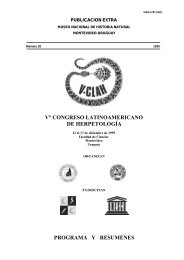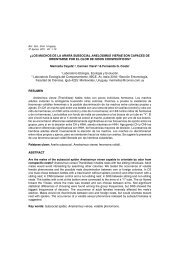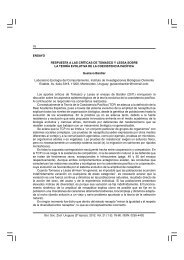Primer Congreso Uruguayo de Zoología - Sociedad Zoológica del ...
Primer Congreso Uruguayo de Zoología - Sociedad Zoológica del ...
Primer Congreso Uruguayo de Zoología - Sociedad Zoológica del ...
You also want an ePaper? Increase the reach of your titles
YUMPU automatically turns print PDFs into web optimized ePapers that Google loves.
SPATIAL DISTRIBUTION OF ANURANS AMONG BREEDING SITES IN SOUTHEASTERNBRAZIL: TESTING FOR INDICATOR SPECIES OF ENVIRONMENTAL HETEROGENEITYdos Santos, T.G. 1,2 , da S. Vasconcelos, T. 2 & C.F.B. Haddad. 21 Universida<strong>de</strong> Fe<strong>de</strong>ral do Pampa (UNIPAMPA), São Gabriel, Rio Gran<strong>de</strong> do Sul, Brasil. 2 Departamento <strong>de</strong> Zoologia, Instituto <strong>de</strong>Biociências, Universida<strong>de</strong> Estadual Paulista, Rio Claro, São Paulo, Brasil.We studied patterns of spatial distribution of anuran assemblages in Morro do Diabo State Park, the biggest remnantof Mesophytic Semi<strong>de</strong>ciduous Forest in the Brazilian state of São Paulo, testing for indicator species of environmentalheterogeneity. We found that the spatial distribution of species among breeding sites differed from that expected byrandom distribution and comprised three distinct anuran assemblages that were explained by the suite ofenvironmental variables consisting of permanent streams and dams, and temporary ponds (SIMPROF similarityprofile tests). Through indicator species analysis, nineteen species (83% of total anuran species recor<strong>de</strong>d inmonitored sites) were indicators of environmental heterogeneity: three species indicated permanent streams(Hypsiboas albopunctatus, H. lundii, and Rhinella ornata), four indicated permanent dams (Dendropsophus nanus,Hypsiboas punctatus, Scinax fuscomarginatus, and S. fuscovarius), and 12 species indicated temporary ponds(Chiasmocleis albopunctata, Dendropsophus minutus, Elachistocleis bicolor, Hypsiboas raniceps, Leptodactyluschaquensis, L. fuscus, L. mystacinus, L. podicipinus, Physalaemus cuvieri, Scinax berthae, S. similis, and Trachycephalusvenulosus). We discuss the spatial patterns based on specific characteristics of breeding sites (water flow,productivity, pressure of aquatic predators, and permanence gradient) and the ecology of the species, as well as wehighlight the implications of our study for conservation strategies of anurans in the Mesophytic Semi<strong>de</strong>ciduousForest. Financial support: BIOTA/FAPESP, CAPES, and CNPq.DISTRIBUCIÓN POTENCIAL DE Ramphastos toco EN URUGUAYDuarte A. 1 , Hernán<strong>de</strong>z D. 1,2 , Tosi-Germán R. 2 & Machín E. 21 Secc. <strong>Zoología</strong> <strong>de</strong> Vertebrados, Dpto. <strong>de</strong> Ecología y Evolución, Facultad <strong>de</strong> Ciencias. 2 Asociación Averaves. gallego<strong>de</strong>z@gmail.comEl tucán gran<strong>de</strong> Ramphastos toco es la especie <strong>de</strong> mayor tamaño <strong>de</strong> la familia Ramphastidae y se encuentraampliamente distribuido en Surinam, Guayana Francesa, Guyana, Brasil, Perú, Bolivia, Paraguay y el norte <strong>de</strong>Argentina. A diferencia <strong>de</strong> las <strong>de</strong>más especies <strong>de</strong> tucanes, que se encuentran restringidos a ambientes <strong>de</strong> selva, R.toco se <strong>de</strong>splaza a través <strong>de</strong> zonas semiabiertas, sin corredores <strong>de</strong> monte, siendo muy común en la zona <strong>de</strong> Pantanaly el Cerrado. Des<strong>de</strong> el año 2008 se han observado individuos <strong>de</strong> tucán gran<strong>de</strong> en el Área Protegida Quebrada <strong>de</strong> losCuervos (Departamento <strong>de</strong> Treinta y Tres), siendo los primeros registros para Uruguay y los más australes para laespecie. Se realizó un mapa <strong>de</strong> distribución potencial <strong>de</strong> R. toco para nuestro país utilizando la herramienta BIOCLIM<strong>de</strong>l programa DIVA-GIS v4. El mapa obtenido muestra probabilida<strong>de</strong>s <strong>de</strong> presencia bajas, medias y altas para elnoreste y este <strong>de</strong> Uruguay, correspondientes a la cuenca alta <strong>de</strong>l Río Negro y <strong>de</strong> la Laguna Merín. Esta distribuciónabarca a<strong>de</strong>más <strong>de</strong> la Quebrada <strong>de</strong> los Cuervos, la zona <strong>de</strong> Paso Centurión, propuesta para ingresar al SistemaNacional <strong>de</strong> Áreas Protegidas (SNAP), y está muy cercana <strong>de</strong>l Valle <strong>de</strong>l Lunarejo y <strong>de</strong> Laureles (ingresada y en vías <strong>de</strong>ingreso al SNAP respectivamente). Aunque no se conoce el tamaño poblacional <strong>de</strong> la especie en Uruguay, supresencia en nuestras Áreas Protegidas pue<strong>de</strong> cumplir dos roles ecológicos no excluyentes: por un lado cambiar ladinámica <strong>de</strong> regeneración <strong>de</strong>l monte nativo por dispersión <strong>de</strong> semillas, y por otro, impactar las poblaciones <strong>de</strong> otrasaves por predar sobre sus nidos. Se requerirá un seguimiento <strong>de</strong> la especie para monitorear estos impactos, y seríannecesarios estudios genéticos para evaluar si esta población llegó a nuestro país en forma natural o si se originó porindividuos liberados <strong>de</strong> cautiverio.178 <strong>Primer</strong> <strong>Congreso</strong> <strong>Uruguayo</strong> <strong>de</strong> <strong>Zoología</strong>







